


| |
 Art & Travel in Mexico: take a driving vacation to beaches from Puerto Vallarta on the Mexican Riviera Art & Travel in Mexico: take a driving vacation to beaches from Puerto Vallarta on the Mexican Riviera  | |
|
| |
Barra de Navidad: Vacation Paradise in Mexico's Jalisco StateWe spent the first night in Barra de Navidad, hoping to run into our good friend Paulina, who we'd arranged via email to meet (she had come up from Zihautanejo for a holiday break to meet with other friends from Nanoose). Sure enough, there she was, walking down the pedestrian-only street right where we were hanging out, where I was enjoying the best vanilla ice cream I've ever tasted! It's that kind of place, small enough that you'll run into your friends sooner or later, if you just keep walking around for a while.
Barra De Navidad (Bar of Christmas) is a bustling, folksy little town, chock full of hotels, restaurants, shops and bars, and it's great fun just to be walking around. It's also one of the best places we've seen to buy authentic one-off Mexican objet d'art. The downtown core, located on a sand spit that creates a channel into a sheltered lagoon, is only about 4 or 5 blocks wide a its widest point, tapering to a single block at the entrance to the malecon that occupies the very end of the spit (see map above).
The Malecon (picture above) at the end of the sandbar is a pedestrian walkway that provides a terrific spot to sit on the beach and swim, drink Corona from the beer vendor, and watch all the harbour activity. In the picture to the left, you can just see Melaque on the other side of the bay, in the background. The statue on the Malecon beach celebrates the legend and character of the 'Costalegre' coast. There are numerous restaurants on the lagoon side of Barra, and if you need a break from the ocean breeze (it can get intense at times), the lagoon side of town is quite sheltered. For serious boaters, the huge lagoon provides a very sheltered anchorage, and there is a marina with recessed boat canals that are totally protected from outside waters. With marine repairs and servicing available, this is a great place to keep a boat, if you're so inclined. Directly across the entrance to the lagoon at the end of the Malecon, the Isla de Navidad (below) rises up in front of the town, with the luxurious Grand Hotel complex sitting like a sentinel on the hillside.
We discovered that although Isla de Navidad at first looks very much like an island, it is not actually an island, although it could be very quickly if Greenland melts and the oceans rise up much. It is really the rocky outcropping at the end of a sandy peninsula, and you can actually drive there by going a long way around on paved road, although you'll arrive at a security gate long before you get to the hotel as the entire 'island' is private property. My understanding is that you can request permission to drive on to the little village of Colimilla on the lagoon side of the island, but taking a panga hire from Barra is much faster. Another interesting factoid is that the Barra de Navidad lagoon is actually created by the outflow of the Rio Marabasco (see map above), which defines the border between Jalisco and Colima states, so when you're standing on the viewing pier at the end of the malecon, looking over the entrance to the lagoon, you're in Jalisco, but the Isla de Navidad shore about 30 feet away is in Colima state. 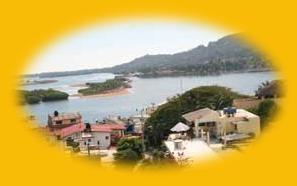 If you want a nice cold drink with a great view, try the rooftop open-air bar five stories up at the Hotel Alondra in the center of town - you can see a full view of the Laguna and Isla de Navidad, or anything else you want to look at in any direction.
These tables full of beautiful silver jewelry were a sight to see, and the prices weren't bad at all - a very good value, I thought.
The wave also made it halfway through town, creating havoc, but fortunately no one was killed, although there were apparently many broken bones and related injuries. Melaque, Tenacatita Bay, Manzanillo and other parts of the region were similarly affected, with 5 to 6 feet of water inundating some towns. The entire Mexican coast is at risk due to the tectonic plate intersections just offshore, just as the California to British Columbia coast is. Unlike the disaster in Indonesia in 2004, there is a Tsunami warning system in place, and plenty of high ground nearby. NEXT DESTINATION: Melaque |
|
| TRAVEL & ART in MEXICO - MENU |
HOME COSTA AZUL Sayulita Bungalow Rentals Villa Rentals San Francisco (San Pancho) Rincon de Guayabitos Chacala BAY OF BANDERAS Puerto Vallarta Puerto Vallarta Via Boeing 787 Soon COSTA ALEGRE Barra de Navidad Melaque Cuastecomate Tenacatita Cihuatlan - Carlos Santana walked here COLIMA STATE Manzanillo Colima City Volcano of Fire Colima Volcano Satellite Photo MAYAN RIVIERA MEXICO WEATHER
This website was created with XSitePro and is hosted by our sister company - AeroHOST Web Systems
Copyright © 2002-2008 - Mexico Art and Travel - All Rights Reserved


 The name Barra de Navidad was given after the first Viceroy of Mexico, Antonio de Mendoza, disembarked there on Christmas Day, 1540, to put down a bloody rebellion that threatened to destroy New Spain. He succeeded after thousands of natives in revolt were tortured, hung and beheaded. It's hard to believe that such a beautiful, peaceful place has such a bloody history.
The name Barra de Navidad was given after the first Viceroy of Mexico, Antonio de Mendoza, disembarked there on Christmas Day, 1540, to put down a bloody rebellion that threatened to destroy New Spain. He succeeded after thousands of natives in revolt were tortured, hung and beheaded. It's hard to believe that such a beautiful, peaceful place has such a bloody history.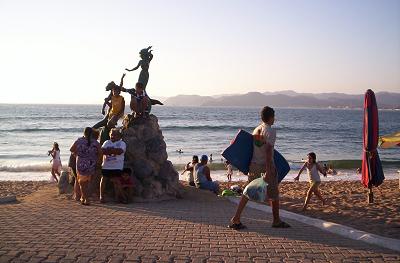 On one side you have the ocean beach, and on the other side you have the calmer lagoon (Laguna de Navidad). The view of Melaque across the bay is spectacular, and you also get a good view of the surrounding countryside as there are no tall buildings in the way.
On one side you have the ocean beach, and on the other side you have the calmer lagoon (Laguna de Navidad). The view of Melaque across the bay is spectacular, and you also get a good view of the surrounding countryside as there are no tall buildings in the way. 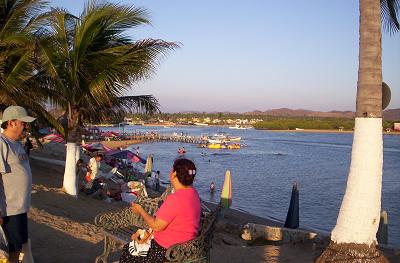 We found it fun to dine and watch the rental boat traffic as it came and went from the little docks just at the base of the spit. This picture shows the lagoon activity, marina and boat canals, and some of the low lying hills on the valley floor in the background).
We found it fun to dine and watch the rental boat traffic as it came and went from the little docks just at the base of the spit. This picture shows the lagoon activity, marina and boat canals, and some of the low lying hills on the valley floor in the background).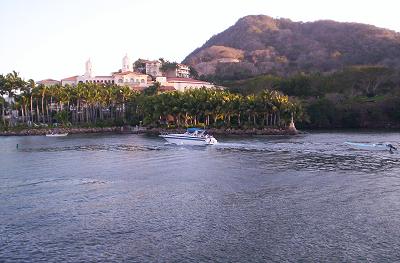
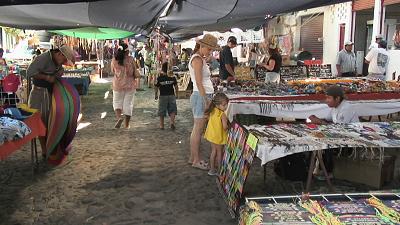 Saturday is market day in Barra de Navidad, and you'll find a huge array of products available. About 6 blocks of street get closed off, and the area is chock full of clothing, arts and crafts, household items, and just about anything else you can think of. This picture gives you an idea of what it's like, and I really liked the way they hung cloth shades above the street to keep the heat down.
Saturday is market day in Barra de Navidad, and you'll find a huge array of products available. About 6 blocks of street get closed off, and the area is chock full of clothing, arts and crafts, household items, and just about anything else you can think of. This picture gives you an idea of what it's like, and I really liked the way they hung cloth shades above the street to keep the heat down.
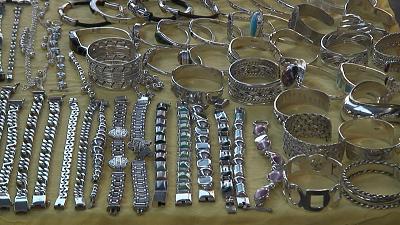 Despite the spectacular beauty of this coastal paradise, it is not without its perils. In 1995 it was struck by a major earthquake (magnitude 8.0), damaging several large concrete hotels in the area beyond repair, and 15 minutes later, a tidal wave (maremoto) hit Barra De Navidad, sweeping tourists off the bar into the lagoon.
Despite the spectacular beauty of this coastal paradise, it is not without its perils. In 1995 it was struck by a major earthquake (magnitude 8.0), damaging several large concrete hotels in the area beyond repair, and 15 minutes later, a tidal wave (maremoto) hit Barra De Navidad, sweeping tourists off the bar into the lagoon. 